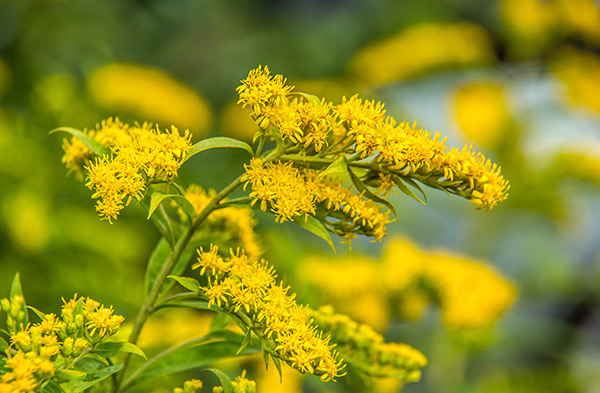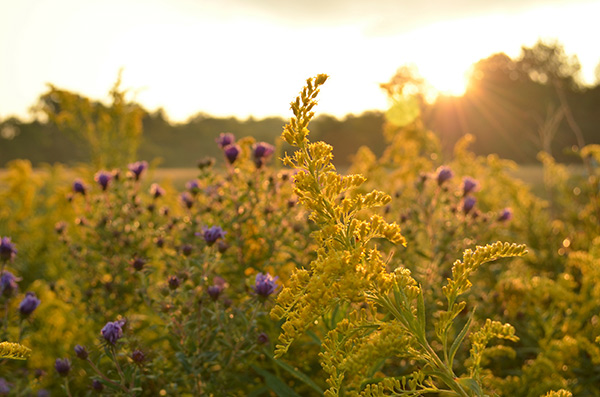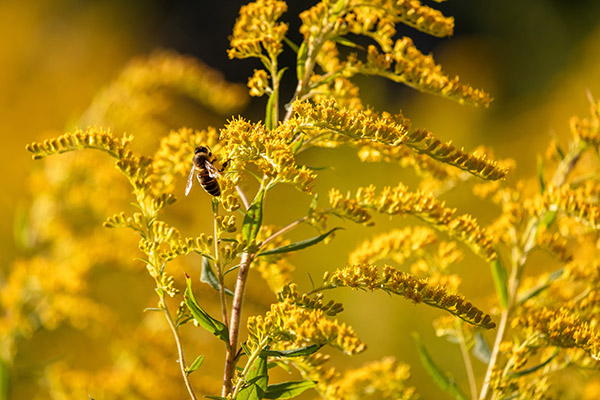Subtotal: $
Checkout
The Generous Goldenrod
What does autumn’s signature flower have in common with the middle-aged sad dad?
By William Thomas Okie
October 26, 2023
It has been a long summer, and apocalyptically hot at the very end. But fall is here now. Coffee shops are putting nutmeg syrups into their hot drinks. Decorative gourds are piling up in parking lots and on dining room tables and front stoops, “as though a drunk giant had been staggering around suburbia all night, vomiting pumpkins,” as Margaret Renkl recently put it. And goldenrods are painting the world yellow. What was just generic greenery in that field, ditch, median, or fence line is suddenly a brassy ushering in of autumn – and everything the season represents.
Goldenrods bloom with geometrical extravagance. From a distance, they look like scraggly brushes dipped in bright yellow paint, or like golden snow draping the branches of tiny conifers. Up close, the panicle, or flowering top, of the plant is composed of racemes, long stems with upturned yellow flowers. I waded into a field and plucked a modest goldenrod panicle, which comprised twenty-three racemes. I counted twenty-eight flower heads on one raceme and forty-nine on another. So any given panicle might contain between five hundred and a thousand flower heads. But then each flower head is composite, too, containing somewhere between two and sixty disc florets, surrounded by a handful of ray florets. (Picture a tiny sunflower, the disc florets in the center and the ray florets providing the petals.) My little goldenrod panicle had flower heads composed of six to eight florets, bringing our total to somewhere between three and eight thousand diminutive flowers on a single panicle. Even if there are only two goldenrod plants per square foot, an acre of the stuff could contain a half-billion flowers.
This is absurd prodigality. Why does a plant need so many flowers? “I never knew the earth had so much gold,” anthologist Louis Untermeyer exclaimed in 1914:
The fields run over with it, and this hill
Hoary and old,
Is young with buoyant blooms that flame and thrill.
Such golden fires, such yellow – lo, how good
This spendthrift world, and what a lavish God!
In Untermeyer’s hands, goldenrod is a garment put on by an old man to give him the semblance of youth, with its “flame and thrill.” Helen Hunt Jackson framed the same phenomenon somewhat less charitably a couple decades earlier. Best known for her books A Century of Dishonor and Ramona, which together galvanized political action on behalf of Native Americans in the late nineteenth century, Jackson could be a harsh critic. “The history of the United States government’s repeated violations of faith with the Indians thus convicts us,” she wrote, “of having outraged the principles of justice.”

Photograph by alatielin. All images from stock.adobe.com.
Jackson’s critical eye also shows up in less likely places, such as A Calendar of Sonnets, an illustrated volume for children. It’s mostly sweet and inoffensive stuff. But “August” is a dart. It reads in part:
Pathetic summer seeks by blazonry
Of color to conceal her swift decrease
Weak subterfuge! Each mocking day doth fleece
A blossom, and lay bare her poverty.
Poor middle-agèd summer! Vain this show!
Whole fields of golden-rod cannot offset
One meadow with a single violet.
Jackson pegs goldenrod as the flower of middle age as well as of summer’s end: pathetic, vain, declining, ridiculous. The goldenrod drives a red convertible, toupee flapping in the wind, as the trophy wife pretends not to notice.
That autumn is the season of middle age is an old idea. The ancient and medieval world was a fourfold place: four elements (water, earth, fire, air), four humors (phlegm, blood, black bile, yellow bile), four characteristics of matter (hot, cold, dry, wet). And there were four ages of humans (infancy, youth, middle age, old age), which corresponded to the four seasons (spring, summer, fall, winter). In her “Four Ages of Man,” the Puritan poet Anne Bradstreet put a stalk of goldenrod in the purse of the middle-aged man. The child, “cloth’d in white, and given to show” ran recklessly across the stage; the youth pranced around in crimson, green, and gillyflowers. The middle-aged fellow came “in a graver sort, / as one that cared for a good report.”
I feel seen.
The middle-aged folk I know are somewhat graver, a bit more weighed down. We have boring hair and clothes. We’ve lost loved ones to illness or accident or acrimony. We’ve torn ligaments. And as the last generation to have childhoods beyond the reach of the internet and the smartphone, we bear the ridiculous burden of nostalgia for the 1990s. “I and others of my generation have had to bear the peculiar double load of arriving at this treacherous period of the life cycle,” writes Justin E. H. Smith, “at precisely the same moment that people of all ages recognize to be a time of great cultural and political upheaval.” “It’s so sad when old people romanticize their heydays,” Fredrik deBoer remarks, in a slightly punchier tone. “Also, the ’90s were objectively the best time to be alive.” The “sad dads” of The National are out with a new album and an ostensibly unlikely collaboration with Taylor Swift, and like Swift’s teenage fangirls they are, as Phoebe Bridgers observes, “finding themselves and being kind of self-conscious.” We are in the midst of that sizing-up evaluation cycle that columnist Tim Kreider calls “The Referendum.” We care what people think. We want a good report.

Photograph by redtbird02
Part of what makes middle age such a fabulous time for handwringing, it turns out, is the dawning awareness that there are so many ways to fail. You can fail to get promoted or to make good investments. You can fail to get regular oil changes or to fix the bathroom leak. You can fail to call your mom, or to visit your friend in the hospital or your nephew in prison. You can fail to curb your calories, or to take enough steps, or to get enough sleep. You can fail to be present with your children, or to provide firm boundaries, or to offer loving acceptance when the boundaries are transgressed. And thanks to the internet, you can imagine that your failures will be remembered forever. Maybe that’s why the retreat into luxury – craft liquors or fine coffees or expensive fountain pens – is such a compelling option, offering small areas of meaningless but finely tuned expertise. For Helen Hunt Jackson, that’s what goldenrod means. Knowing that death is looming, it tries through “weak subterfuge” to hide that fact. Goldenrods are all aflame with delusions of grandeur, like middle-aged authors and artists limning the exquisite pain of getting older and realizing you’re not that great.
Goldenrods are showy, sure, and maybe some of them are vain too. But they are also multifariously generous – and generative.
Judgment is in the eye of the beholder. What looks like gaudy display to a stern Victorian like Jackson may seem like lavish generosity to another. To an insect, for instance. Goldenrods host more than a hundred species of butterflies and moths, and feed over forty species of specialist pollinators. Other insects lay eggs in the stems, to which the goldenrod responds by forming a gall, a spherical knot that makes an adorable little high-security house for the goldenrod gall fly larva. The galls lend a blow-pop appearance to wintertime goldenrod stalks, and that’s pretty much what they look like to a group of slightly larger creatures. Galls are an important wintertime food source for grey squirrels, chickadees, and downy woodpeckers, among others, which puncture the galls to consume the larvae inside.
Galls are also an important resource for the even more imposing animals known as American biology teachers, since, as one teacher put it, “goldenrods and the associated gall-forming insects are often abundant” in the “old-field habitats” that are “accessible to groups of students.” And science teachers are just the most recent humans to find something valuable in goldenrods. Goldenrod flowers, leaves, stems, and roots have been used for everything from treating diarrhea and nasal congestion to making basketry and play whips, and the seeds and roots can be eaten. For the Omaha people on the summer buffalo hunt, goldenrod blossoms meant it was time to go home, for the corn planted there was ripening. For prosperous hay fever sufferers in the nineteenth century, goldenrod indicated that it was time for vacation in the mountains. Goldenrod pollen is sticky and not much of an allergen, but it blooms alongside inconspicuous ragweed, whose pollen is windborne and hyperallergenic.
In the 1920s, goldenrod seemed valuable in a more obviously utilitarian way. The “chemurgy” movement touted the chemical, nonfood uses of agricultural crops like sweet potatoes, soybeans, and peanuts. George Washington Carver’s fame as the peanut scientist was part of the chemurgy movement. So was Henry Ford’s “soybean car,” with panels composed of lightweight soy-based plastics. And so was Thomas Edison’s efforts to extract latex from goldenrod. Edison was eighty years old when he began his rubber research in earnest in 1927, and an old hand at generating publicity. As historian Mark Finlay documented in Growing American Rubber, Edison claimed to have considered seventeen thousand plants before he settled on Leavenworth’s goldenrod (Solidago leavenworthii), a species common in Florida and coastal Georgia. He enlisted a wide network of collaborators, colleagues, and acolytes in his campaign – Henry Ford, Firestone Tires, the Union Pacific Railway, and a far-flung “rubber research network” – and soon had newspapers sharing his vision of southern wiregrass farmers turning their worked-out cotton fields into productive rubber plantations with a weed that grew without effort.

Photograph by Serge.
As it turned out, goldenrod rubber occupied the last four years of Edison’s life; his staff brought him a piece of successfully vulcanized goldenrod rubber on his deathbed just a few days before he died in October 1931. A decade later, when World War II endangered global rubber supplies and made Edison’s research newly relevant, the federal Emergency Rubber Project proposed a $54 million plan to plant a million acres of goldenrod across the South and generate 25,000 jobs in the process. Instead, $426,000 was appropriated to plant 610 acres in two Georgia counties and employ 468 workers. The harvest in 1943, not quite seven hundred pounds of rubber, was not even a drop in the bucket of the overall US demand for more than a billion pounds per year. Although goldenrod is rich in latex, the most promising varieties were poorly adapted beyond the Deep South and hard to process. By 1945 the narrative was already shifting to petroleum-based synthetic rubber as the foregone conclusion of the domestic rubber program.
But goldenrods didn’t seem to take this failure to underwrite US industrial self-sufficiency to heart. They kept right on blooming with their usual unrestrained abundance, filling up the irregularly mown corners of our world with cheerful disregard for our strivings and failures alike, supplying the bees and caterpillars and gallflies and woodpeckers and science teachers with what they needed, without fear or favor. For Robin Wall Kimmerer, growing up in the 1960s, goldenrods provided a vocational turning point. As she relates in her bestseller Braiding Sweetgrass, her remarkable career as a bryologist (moss expert) began with the fact that New England asters and goldenrods grow together and complement each other so strikingly, the purple disk-shaped asters with golden centers just the color of the spiky goldenrods growing in their midst. Why do they do that? she wanted to know.
Which is to say: Why is the world so beautiful?
That’s a good question to ponder, whether the goldenrods are in full glory or whether they’ve faded to dull brown. Taking in a field of goldenrods is its own kind of tonic. As we come to terms with our limits and failures, asking questions we will never have the answer to, like “Why do they do that?” can help to purge us of self-importance. Goldenrods inhabit a practically limitless world and are undismayed by failures. They have no shame.
So instead of just admiring goldenrods from a distance and mocking their “vain show,” we could lean in, count the flowers, count the bees visiting the flowers, catch an ovipositing insect in the act. And we could be gentle with the “poor middle-agèd” folks in our lives. Goldenrods are showy, sure, and maybe some of them are vain too. But they are also intensely and multifariously generous – and generative. They feed vagrant organisms and protect the vulnerable young through the long, cold darkness. They foster the flourishing of others, in their autumns of theatrical display, in their winters of hollow hospitality, and in their springs and summers of lush, nutritious increase.
We could do worse than that.
Already a subscriber? Sign in
Try 3 months of unlimited access. Start your FREE TRIAL today. Cancel anytime.







Vicki Shuck
An absolutely wonderful article! Thank you so much for widening my vision today!